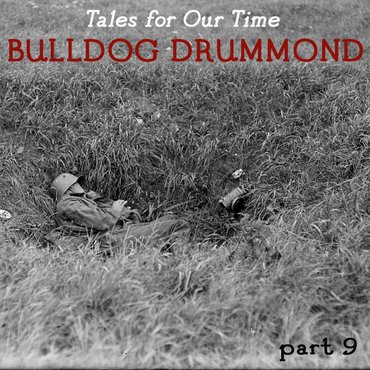Our latest Tale for Our Time charges on: Bulldog Drummond, Sapper's first caper starring the eponymous hero, and set against the turbulent politics of the world after the Great War.
In tonight's episode, the author gives us a glimpse of his protagonist's backstory:
In the days when Drummond had been a platoon commander, he had done many dangerous things. The ordinary joys of the infantry subaltern's life—such as going over the top, and carrying out raids—had not proved sufficient for his appetite. He had specialised in peculiar stunts of his own: stunts over which he was singularly reticent...
Enormous physical strength is a great asset, but it carries with it certain natural disadvantages. In the first place, its possessor is frequently clumsy: Hugh had practised in France till he could move over ground without a single blade of grass rustling. Van Dyck—a Dutch trapper—had first shown him the trick, by which a man goes forward on his elbows like a snake, and is here one moment and gone the next, with no one the wiser.
Again, its possessor is frequently slow: Hugh had practised in France till he could kill a man with his bare hands in a second. Olaki—a Japanese—had first taught him two or three of the secrets of his trade, and in the intervals of resting behind the lines he had perfected them until it was even money whether the Jap or he would win in a practice bout.
And there were nights in No Man's Land when his men would hear strange sounds... Perhaps a patrol coming back would report a German, lying huddled in a shell-hole, with no trace of a wound, but only a broken neck; perhaps the patrol never found anything. But whatever the report, Hugh Drummond only grinned and saw to his men's breakfasts. Which is why there are in England to-day quite a number of civilians who acknowledge only two rulers—the King and Hugh Drummond. And they would willingly die for either.
Members of The Mark Steyn Club can listen to Part Nine of our adventure simply by clicking here and logging-in. Earlier episodes can be found here.
Thank you for all your kind comments about this latest serialisation. Re recent episodes, we have had some back and forth on cranking the car from various car cranks - about whether "the girl" (as she is generally referred to) would have been no better at cranking a car than the average Secret Service agent, plus some dispute as to whether, in 1920, Captain Drummond's two-seater would have even had a crank. Laura McIntyre, an Oklahoma Steyn Club member, weighs in:
Mark, in the US, well into the 1930's, people were still cranking cars to start them. The reason was that people who bought Model T Fords and similar vehicles with crank starting could not afford to replace them until they were worn out.
My mother told the story of how, as a neophyte driver in the year 1938, she managed to stall the engine on the family Model T while crossing a railroad track in rural Oklahoma in front of an oncoming train. My grandfather, a man with the reputation for never moving above a snail's pace, leapt out of the passenger's seat, ran around to the front of the car with the speed of a gazelle, frantically cranked the engine to restart it, and sprang nimbly back into the car as my mother drove it off the tracks just ahead of the whistling locomotive.
'He never moved that fast in his life, before or after,' marveled my mother.
Nothing like an oncoming locomotive to concentrate the mind. If you've yet to hear any of our Tales for Our Time, you can do so by joining The Mark Steyn Club. Membership is available now - and, if you sign up, you'll be all set for Part Ten of Bulldog Drummond this time tomorrow (and all the earlier episodes, of course). And, if you've a friend who likes classic fiction, don't forget our special Gift Membership.


